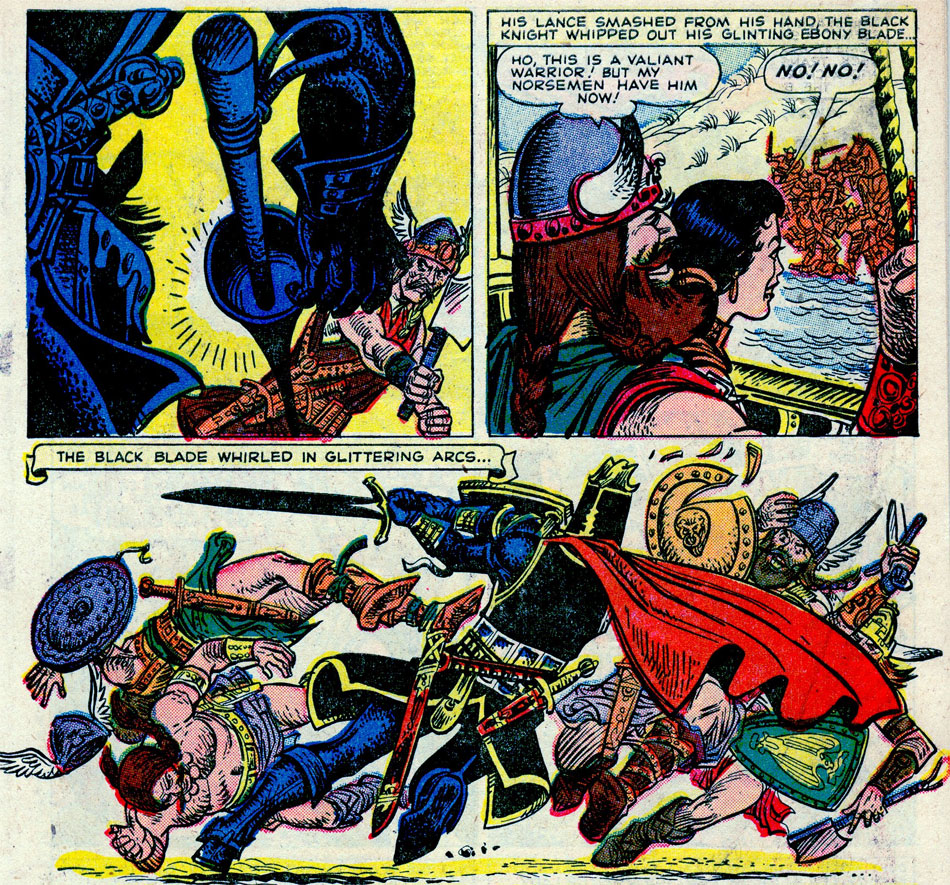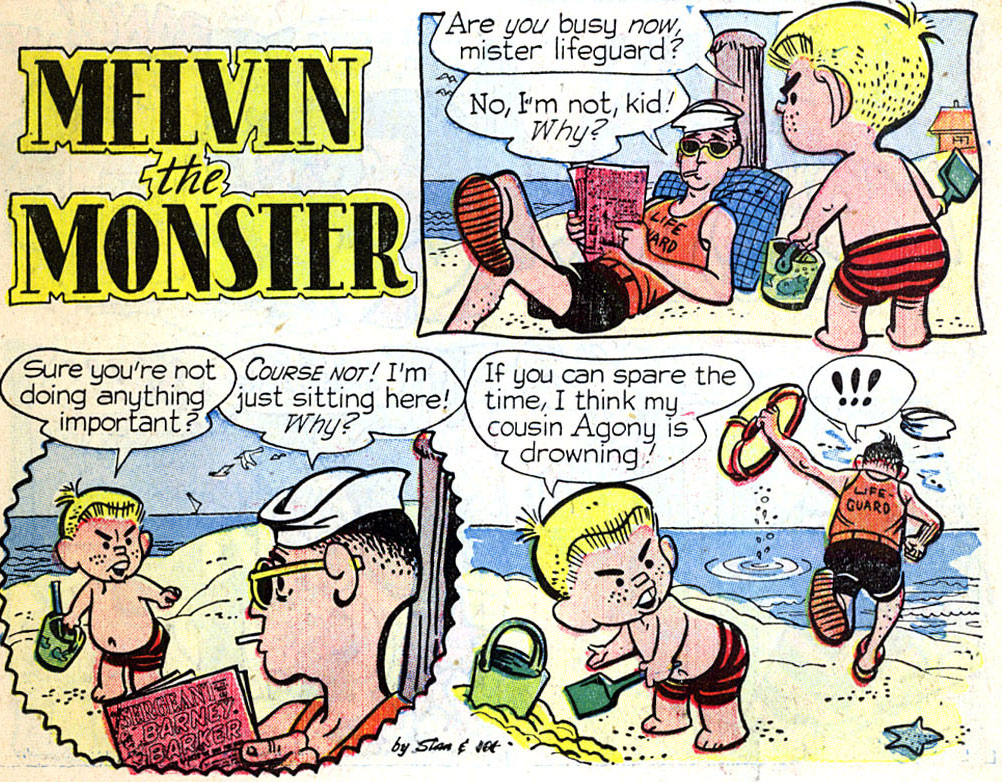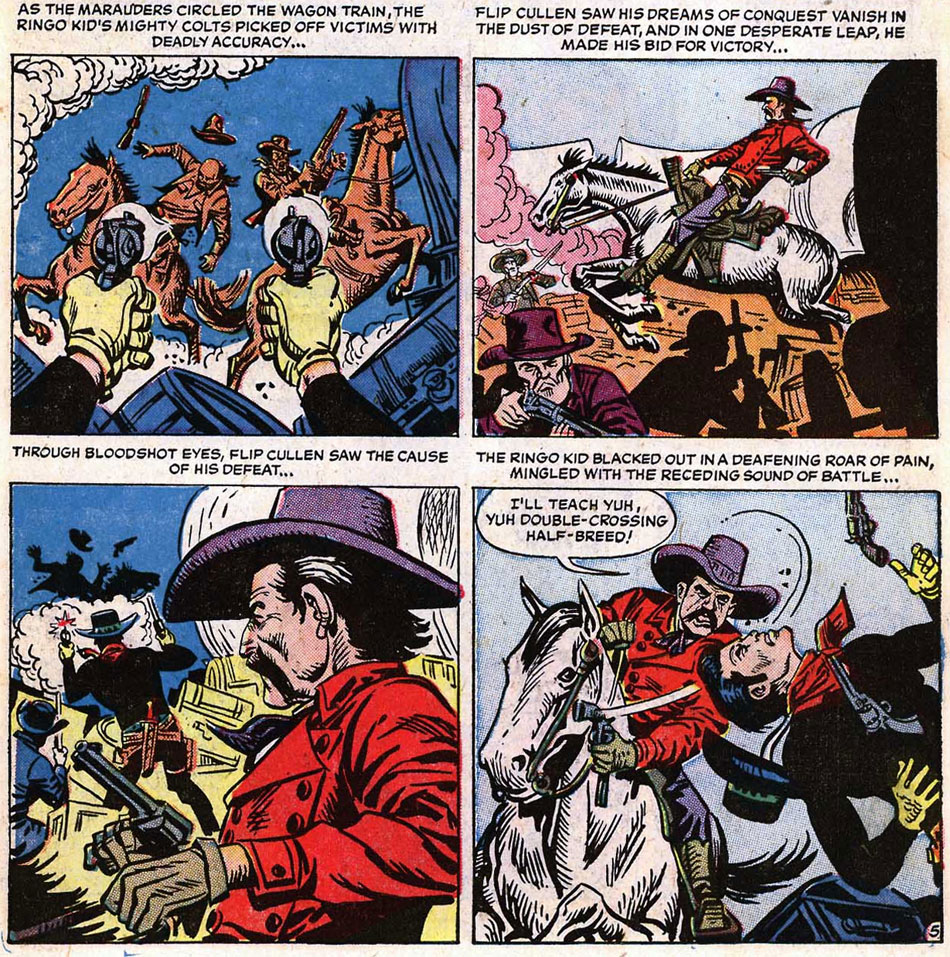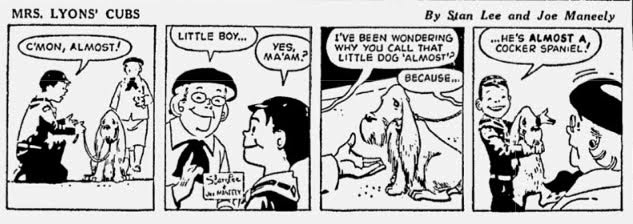'Black Knight' #2 (July 1955).
Joe Maneely was a mid-20th century American comic book artist. Between the late 1940s and late 1950s, he was a frequent contributor to Atlas Comics (nowadays Marvel Comics), and one of the key collaborators of its editor, Stan Lee. A swift jack-of-all-trades, he drew many stories in equally plentiful different genres. He is best remembered as the co-creator and main artist of titles like 'Ringo Kid' (1954-1957), ' Black Knight' (1955-1956) and 'Yellow Claw' (1956-1957). This latter series introduced both the master villain Yellow Claw and the heroic secret agent Jimmy Woo, who was later featured in several other Marvel comic books. With Stan Lee, Maneely also created the 'Melvin the Monster' (1956-1957) comic book, as well as the newspaper gag-a-day strip 'Mrs. Lyons' Cubs' (1957-1958). A tragic train accident ended his career at age 32, making him one of the great "what if?" stories in the history of comics.
Early life
Joseph Maneely was born in 1926 in Philadelphia, Pennsylvania, in a large, but poor family. As a student at the local North East Catholic High School, he designed the school mascot, The Red Falcon. Maneely also drew a comic strip about the bird for the school newspaper. Maneely never finished his education, but during World War II, he enlisted in the U.S. Navy. During his military service, he drew cartoons for army magazines.
Post-war career
After World War II, Maneely was able to get a proper art education at the Hussian School of Art in Philadelphia through the G.I. Bill. His first job was helping at the advertising art department of The Philadelphia Bulletin. In 1948, he and fellow artists George A. Ward and Peggy Zangerle shared an art studio in the Flo-Mar Building in Philadelphia. By then, Maneely was a freelance comic artist for several publishers, working on various realistically-drawn action and crime comics. At Street and Smith, his credits included features such as 'Roger Kilgore', 'Django Jinks Ghost Chaser', 'Nick Carter', 'Public Defender', 'Tao-Anwar', 'Supersnipe', 'Butterfingers', 'Mario Nette', 'Red Dragon' and 'Ulysses Q. Wacky' for comic books like The Shadow, Top Secrets, Ghost Breakers and Super Magician Comics. He additionally appeared in Hillman Periodicals' Airboy Comics and in issues of the Catholic bi-weekly comic magazine Treasure Chest, published in Ohio by George A. Pflaum.
During the 1950s, Joe Maneely was working almost exclusively for Atlas Comics, the successor of Timely Comics and predecessor of Marvel Comics. His later non-Atlas work included two four-page educational comics about Social Security for the U.S. Department of Health, Education and Welfare: 'John's First Job' (1956) and 'A Farm and a Family'.
'Dead Man's Escape' (Adventures Into Terror #11, August 1952).
Atlas Comics
At Atlas Comics, Maneely's work really began to shine. His unique and efficient style appealed to the publisher's editor Stan Lee. It is said that Maneely could pencil and ink seven pages in a single day. His pencil sketches were deliberately soft. He worked everything out while inking, rather than trace his finished pencil drawings with ink. Known for his elegant figures and dynamic action, Maneely was commissioned to draw various magazine covers and stories. He proved himself to be a veritable chameleon, working on all of Atlas' comic books, no matter what the subject matter was. Thanks to his speed and versatility, Maneely was held in high esteem by his bosses. They nicknamed him "Joe Money", as he was such a lucrative artist in their team.
'Melvin the Monster' gag strip from Melvin the Monster #3 (November 1956).
Among Maneely's early work for Atlas were contributions to the western titles 'Western Outlaws and Sheriffs', 'Black Rider', 'Whip Wilson' and 'Kid Colt Outlaw'. He also appeared as a story artist in horror/mystery comic books like 'Suspense', 'Astonishing', 'Menace', 'Adventures into Weird Worlds' and 'Adventures into Terror', as well as the war titles 'Battle', 'War Comics', 'Combat Kelly' and 'Men in Action'. Maneely was additionally the lead artist in the Spaceman comic book, drawing the feature 'Speed Carter, Spaceman' (1953-1954). Tackling every genre imaginable, Maneely's art appeared in the humor/satire titles Crazy, Wild, Riot and Snafu, and also in the romance comic books 'Love Romances', 'Lovers' and 'Girl Confessions'. Among Maneely's later comical work was Stan Lee's 'Melvin the Monster' comic book (1956-1957), starring an obvious copy of Hank Ketcham's 'Dennis the Menace', and the single issue of Cartoon Kids (1957) with characters like 'Willie the Wise-Guy and Peaches', 'Little Zelda' and 'Dexter the Demon'.
Ringo Kid
Besides being a contributor to several of the company's anthology titles, Maneely was co-creator of several enduring characters at Atlas Comics. The first was 'The Ringo Kid', who debuted in August 1954 in 'Ringo Kid'. The Ringo Kid is a multiracial cowboy, whose mother was a Native American. Since he's not white, people mistreat him. One day the young man is accused of a crime he didn't commit. He becomes an outlaw, taking the name Ringo Kid. The Ringo Kid is not alone on his journeys, as he is accompanied by his trusty horse Arab and his Native American friend Dull Knife. 'The Ringo Kid' ran until September 1957. Other artists who have worked on the comic books were Fred Kida and John Severin.
Black Knight
With Stan Lee, Maneely co-created another black-dressed hero in a historical setting, 'Black Knight'. Set in 6th-century England, the stories follow the adventures of Sir Percy of Scandia, a knight in King Arthur's court. Percy pretends to be a clumsy imbecile to guard his secret double life as the mysterious heroic Black Knight. Only Merlin the wizard knows Percy's real identity. He also gave him a special sword, made from a meteorite. Nicknamed the "Ebony Blade", the weapon almost makes the Black Knight invincible. Almost, because in one episode the Black Knight is killed in battle by a blade made from the same meteorite as his own ebony blade. In later stories, sons and other descendants of Percy each take their famous ancestor's role as the new 'Black Knight'. This narrative allowed Lee and Maneely to have their character experience adventures in other time periods of the Middle Ages as well. Debuting in May 1955, 'Black Knight' ran for five issues until December that year. Apart from Maneely, other stories were drawn by Fred Kida, Syd Shores and Christopher Rule.
'The Yellow Claw', from Yellow Claw #1, October 1956.
Yellow Claw
In October 1956, scriptwriter Al Feldstein and Joe Maneely introduced 'Yellow Claw'. The mini-series follows a Chinese-American secret agent, Jimmy Woo, who works for the F.B.I. Woo is assigned to a special mission. He has to find and stop a Chinese master villain nicknamed "The Yellow Claw", a character obviously inspired by similar Asian supervillains, like Fu Manchu. Although in this comic, his evilness had more political overtones. He was depicted as an advocate of his country's Communist regime and wants to take over the world. While Woo eventually defeats him, both he and the Yellow Claw continued to make appearances in many of Atlas' later comic titles. Other artists who worked on 'Yellow Claw' were Jack Kirby and John Severin.
Mrs. Lyons' Cubs
In 1957, after Atlas Comics ran into financial troubles, Stan Lee and Maneely tried their hands at a daily newspaper comic for The Chicago Sun Times to bring in some desperately needed cash. Syndicated between February and August 1958, 'Mrs. Lyons' Cubs' centered on an old lady who is in charge of a group of boy scouts. Through the Sun's Field Enterprises syndicate, the feature also ran in The Milwaukee Gazette. After Maneely's death in June 1958, some episodes were ghosted by Al Hartley for two months extra. In August of that year the series was canceled.
'Mrs. Lyons' Cubs'.
Death and legacy
In 1958, Joe Maneely suddenly died in a tragic accident. One night he, George Ward and John Severin were traveling by commuter train. To get some fresh air, Maneely walked to the balcony of the train, where he lost his balance and fell to his death. He was only 32 years old. His mysterious death naturally led to all kinds of theories. Stan Goldberg claimed that Maneely had lost his glasses a week earlier and still hadn't found them, nor wore another pair, on that fatal night. This might explain why he didn't notice where he was walking in the dark. John Severin attributed his friend's death to having had a few drinks too much. Others speculated it may have been a suicide. In general, most people agree it was most likely an accident. Either way, Joe Maneely's premature death was a great loss to the world of comics, and the Atlas line of comic books in particular. He left behind a wife and three children. In 2004, Stan Lee commented that if Maneely had lived "he would have been another Jack Kirby (...) the best you could imagine."
Joe Maneely was an influence on John Romita, Sr..
Cover illustrations for Journey Into Mystery issue #29 (December 1955) and Strange Tales #33 (December 1954).










